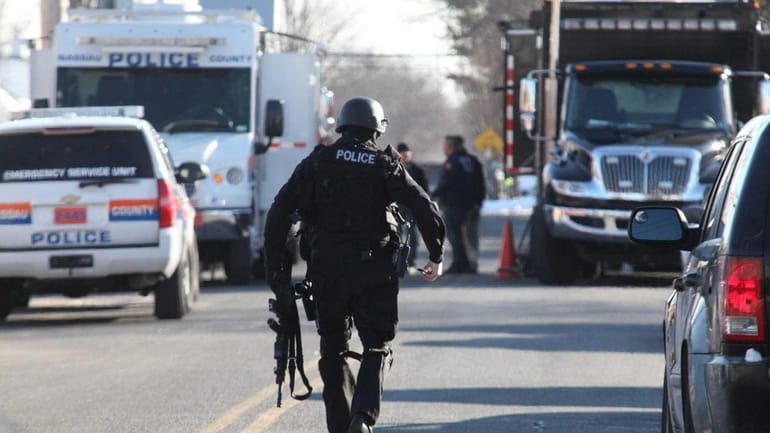Nassau police revamp use-of-force policy, focus on de-escalation

The Nassau County Police Department's new guidelines include changes to the scope of the department's Deadly Force Review Board. Credit: Howard Schnapp
The Nassau County Police Department’s revamped use-of-force policy urges officers to use de-escalation methods rather than physical force, expands and tracks the incidents involving physical force reviewed by top brass and limits the use of the controversial chokehold.
The policy tweaks come about two years after the department embarked on the first major overhaul of its use-of-force policy in more than three decades in the wake of a pair of high-profile shootings involving Nassau officers.
The new guidelines, set to take effect July 8, include changes to the scope of the department’s Deadly Force Review Board, which was created in 2014 and designed to review all police-involved shootings and other incidents where deadly force was used.
Now, the review board will have the option of examining incidents in which any force — as simple as when someone is charged with resisting arrest to a suspect suffering broken bones during an encounter with cops — was used by a police officer.
Additionally, the new guidelines mandate the creation of a written report anytime an officer uses physical force, allowing the department to track the numbers and look for trends and trouble spots that would require retraining and discipline, officials said.
Nassau acting Police Commissioner Thomas Krumpter said the changes to the policy reflect a national evolution in law enforcement emphasizing transparency and the importance of community trust.
“In order for us to build trust, we should be tracking whenever we’re using force,” Krumpter said in a recent interview. “Police officers are given great power. With great power comes great responsibility. Allowing us to track this allows us to look and see if there’s a problem.”
The newest policy guidelines — consisting of 15 changes spanning from more rigorous Taser testing by police officers at the beginning of their shifts to requiring officers to contact the Nassau County Society for the Prevention of Cruelty to Animals when handling stray, abused, diseased or dangerous animals — have been distributed to officers across the department in book form and officers will be required to pass a written test on the new material, Krumpter said.
For example, the new guidelines stress the use of “intermediate weapons,” such as Tasers and Mace, when force must be used, and also add the use of a propelled beanbag round and the deployment of canines to that category of force.
The changes mirror guidelines set forth by the Washington, D.C.-based nonprofit think tank, Police Executive Research Forum, or PERF, which has advised the police department on ethics reforms as part of a three-year, $675,000 contract with the county.
James Carver, president of the department’s largest union, the Nassau Police Benevolent Association, categorized the changes as “minor clarifications” and said much of the new guidelines are already embedded in training.
But, Carver said, he and law enforcement officials at many of the nation’s 18,000 police departments are concerned about a growing reliance on PERF and other organizations to set policy, which he says could endanger public safety.
“An organization like PERF is suggesting if you do everything right, you’ll never have to shoot anybody,” Carver said. “But that thought process is so off base because every situation is so unique and very rarely do you have the exact same circumstances.”
For example, Carver said, “if somebody pulls a gun out at you first, your job isn’t to let someone shoot you first, or to shoot a bystander first. Our job is to protect. And sometimes during the performance of that protecting, it necessitates the use of deadly physical force.”
Chuck Wexler, executive director of PERF, said his organization has long advocated for officer safety, such as mandatory seat-belt and bulletproof vest use.
“Officer safety is very important to us and we’re an organization that focuses on policing and we would never want to advocate any policy that makes officers’ jobs more difficult or risky,” Wexler said. “The idea is we don’t want officers to hesitate. We want officers to think through their best options.”
Wexler said Nassau has been a leader, along with the Fairfax County Police Department in Virginia, in adopting a “critical decision model,” which gives officers “a framework to defuse a situation, slow it down . . . rather than simply rushing in and using force.”
Wexler said PERF has begun to use training videos created by Nassau police training personnel showing the de-escalation model.
“They have embraced every idea we suggested,” Wexler said. “They want to be a leading department. I’ve seen Nassau County really emerge from where it was to really one of the forward thinking departments in the country.”
Krumpter also pushed back against the idea that officers would be hesitant to use force for fear of being disciplined and could be hurt in the process. The commissioner cited new weaponry — such as the Taser, retractable batons that can be easily carried, rifles and tactical body armor and helmets for patrol cops — as evidence that officers have an array of tools at their disposal to use to physically engage suspects.
“The individuals who have police contact determine how much force is going to be used,” said Krumpter, who stressed that the safety of both officers and the public is the top priority of the department. “You don’t want to fuel the fire. You actually want to talk people down. It’s all about putting them in a position to comply with your requests and puting them in a position that they do not force you to use physical force or deadly physical force to the extent possible.”
Suffolk County, too, has looked to update its use-of-force policy. Suffolk Police Commissioner Timothy Sini said he made updates to the department’s use-of-force guidelines and procedures in the past two months, as part of an ongoing review of the department since he became top cop earlier this year.
Among the changes was the creation of a Firearms Discharge Investigation Team, made up of a captain and two lieutenants from the Internal Affairs Bureau, which will investigate all police-involved shootings. Previously, the department’s Homicide Squad handled the investigations.
Anytime an officer uses force, Internal Affairs investigates, Sini said.
“Even if on the face of it, it looks totally legitimate, it doesn’t matter, it goes to Internal Affairs,” he said.
Sini also beefed up Internal Affairs by adding more investigators and a one-star chief and Assistant Commissioner John Barry to oversee the unit.
And additionally, as part of the department’s long-standing federal consent decree agreement with the federal government, Sini said the department has worked to decrease the bureau’s backlog, which has exceeded the federal Department of Justice standard of closing internal affairs cases in 180 days.
Sini said Suffolk also emphasized de-escalation and using force only when “absolutely necessary.”
“Our policy, we believe, strikes the right balance between making sure that our officers can defend themselves and the residents of Suffolk County while not resorting to force prematurely,” he said. “I think it’s very important to teach our officers de-escalation skills and communication skills and in the end I think they’ll be safer for it, actually.”
Suffolk police are reviewing the changes Nassau most recently made to its use-of-force rules and is already preparing to follow suit in one regard, by streamlining the different directives into one centrally located rule book.
“I like the idea of a pamphlet of use of force policy and having everything centralized,” said Sini, who called it “a big project that will take a lot of time.”
When the Nassau County Police Department revamped its use-of-force policy in 2014 — the first time since at least the 1980s — it came as the department’s practices and rules were under scrutiny after then-Nassau Police Officer Anthony DiLeonardo shot a retreating, unarmed cabdriver in Huntington Station while off duty and not in uniform following a night of drinking with another cop. Krumpter later fired DiLeonardo.
Additionally, a uniformed Nassau police officer fatally shot Andrea Rebello, a 21-year-old Hofstra University junior, who was being held hostage at gunpoint by a man during a home invasion in 2013. A report by the Nassau district attorney’s office found the cop was justified in using deadly force.
In 2014, when the department overhauled its use-of-force policy in an eight-month process involving more than 50 members, the new rules also required quicker and more detailed reporting standards: The commissioner has to be notified when an officer uses deadly force within 15 minutes, rather than the previous standard of 48 hours.
And the initial account of the incident must be given to the commissioner before the end of the next business day.
In 2013, Newsday reported that since 2006, Nassau’s deadly force investigators had never found that their officers were wrong when they felt the need to seriously injure or kill someone.
Krumpter denied any incidents that occurred in Nassau informed the department’s revamped policy, saying it’s important for the department to conduct “critical, self analysis.”
But the commissioner acknowledged that the Deadly Force Review Board’s new ability to investigate any case in which an officer used physical force — from striking a suspect with their hands, to using a Taser or Mace — could have included the case of Kyle Howell, the Westbury man who accused Nassau police Officer Vincent LoGiudice of excessive force during an April 2014 traffic stop captured on surveillance video. A judge acquitted LoGiudice last year of felony assault charges in the case.
Howell also has a pending federal lawsuit against LoGiudice, the officer’s partner and the county, alleging civil rights violations stemming from the traffic stop.
The review board consists of Chief of Department Steven Skrynecki, Assistant Commissioner Tatum Fox, Chief of Detectives Kevin Smith and Chief of Patrol Frank Kirby.
“The Kyle Howell case might have been something this board would have looked at,” Krumpter said. “It could be something like that — an in-custody death, or someone ends up with severe physical injury. If . . ., after force is used, a person receives serious physical injuries. It could be a person who resisted arrest and a person’s admitted into the hospital with multiple broken bones. It just gives discretion to the chief of department in serious cases of force that don’t rise to something usually reviewed by the deadly force team.”
The policy also details the accepted use of the carotid restraint, or chokehold, and removes reference to the method from department rules. The restraint can be used, however, if “deadly physical force is being asserted against a member of the department or another,” according to the policy.
Previously, officers could use a chokehold as one of the options of deadly physical force against a suspect.
The chokehold maneuver became the center of national conversation on policing methods after an NYPD officer used the restraint on Eric Garner, an unarmed man peddling illegal cigarettes on a Staten Island street. The NYPD has banned use of the chokehold since 1993.
“Our police officers don’t become cops to go out and use force, they become cops to protect and serve,” Krumpter said. “What we’ve done is provide a significant amount of clarity that didn’t exist . . . They have a clarity on when use of force is appropriate and when use of force isn’t appropriate. We’re providing them with training, we’re providing them with tools.”
Man who drove off North Fork cliff indicted ... Santos drops bid for Congress ... NTSB: 'No gas' in plane ... Knicks look ahead
Man who drove off North Fork cliff indicted ... Santos drops bid for Congress ... NTSB: 'No gas' in plane ... Knicks look ahead

